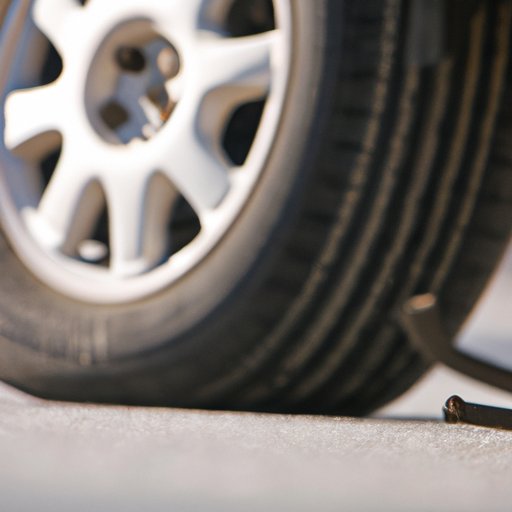
Introduction
Flat tires happen unexpectedly, and while the prospect of driving on a spare tire can be daunting, it’s an unavoidable situation that most drivers will encounter at some point. Knowing how to drive on a spare tire is essential not only for your safety but also for the longevity of your vehicle. In this article, we’ll discuss everything a driver needs to know about driving on a spare tire, including how far you can really go, how to inspect your spare, and what to do in case of a flat tire.
The Ultimate Guide to Driving on a Spare Tire: How Far Can You Really Go?
When faced with a flat tire, many drivers wonder how long they can drive on a spare tire before replacing it with a new tire. The longevity of a spare tire can vary depending on factors such as the type of spare, the condition of the spare, and the type of vehicle. However, as a general guideline, most spare tires are designed to be driven for around 50 miles at a maximum speed of 50 mph. This means that spare tires are intended to be a temporary solution for getting off the road and to the nearest repair shop.
To prolong the life of your spare tire, it’s recommended to drive at a lower speed, avoid rough roads, and limit the distance driven on it. Driving on a spare tire for an extended period can cause the tire to wear down and become unsafe to drive on. It’s also worth noting that some vehicles may have a space-saving, smaller spare tire, which means they are not suitable for long-distance driving and should only be used as a temporary solution.
Spare Tires 101: Don’t Get Stranded on the Road!
Before using a spare tire, it’s important to inspect it first to ensure that it’s suitable for your vehicle. Spare tires can lose air pressure over time, leading to problems with handling and performance. Inspecting a spare tire involves checking the air pressure and examining the tire tread. Step-by-step instructions for inspecting a spare tire include:
- Locate the spare tire.
- Check the tire pressure using a tire gauge.
- Inspect the tire tread for any cracks, bulges, or other visible damage.
When driving on a spare tire, it’s important to drive with caution. Avoid sudden turns or stops, and be sure to reduce your speed. Driving on rough roads or off-road conditions should be avoided to prevent excessive wear and tear.
Running on Empty: How Long Can You Really Drive on a Flat Tire?
A flat tire is a serious risk to the safety of you and your vehicle. Driving on a flat tire can cause significant damage to the wheel rim or suspension and may even lead to an accident. In the event of a flat tire, it’s important to replace the tire as soon as possible with a spare. You should never attempt to drive on a flat tire, even if it’s just for a short distance.
Changing a flat tire is a relatively straightforward process that requires a few basic tools, such as a lug wrench and a jack. The steps for safely replacing a flat tire with a spare include:
- Find a safe location to pull over and park your vehicle.
- Turn on your hazard lights and apply the parking brake.
- Loosen the lug nuts on the flat tire with a lug wrench.
- Use the jack to lift the vehicle off the ground.
- Remove the lug nuts and flat tire.
- Align the spare tire with the wheel studs and slide it onto the hub.
- Hand-tighten the lug nuts onto the wheel studs.
- Lower the vehicle back to the ground.
- Use the lug wrench to tighten the lug nuts.
It’s important to note that specific procedures and tools may vary depending on your vehicle make and model. Be sure to consult your vehicle’s owner manual before attempting to change a tire on your own.
Caution: Proceed with Care When Driving on a Spare Tire
While using a spare tire is a temporary solution to get you to the nearest repair shop, it’s important to drive with caution and avoid overloading your spare tire. Additionally, underinflating a spare tire can lead to handling and safety issues, as well as excessive wear on the tire.
Before driving on a spare tire, it’s essential to inspect the tire’s air pressure and inflate it if necessary. To prevent getting stranded on the road without a spare tire, carrying a portable air compressor or tire sealant can be helpful. These tools can help inflate a flat tire or repair punctures temporarily.
When Good Tires Go Bad: How to Handle a Flat on the Go
Encountering a flat tire while on the road can be challenging, especially if you’re not prepared. In case of a flat tire, staying calm, and calling for help is the best course of action. Some tips for handling a flat tire situation include:
- Call for roadside assistance or a towing company.
- Use a spare tire to replace the flat tire.
- Carry necessary tools like a lug wrench and a jack in your car.
It’s also best to avoid driving on a damaged or flat tire as this can lead to further damage to your vehicle and compromise your safety.
Conclusion
Driving on a spare tire can be a short-term solution to a flat tire, but knowing how to drive on a spare, inspect it, and replace a flat tire is essential for safe driving and vehicle longevity. It’s important to be prepared for a flat tire situation and to know how to act quickly and confidently. By following these guidelines, you can avoid accidents, get back on the road safely, and keep your vehicle running smoothly.




